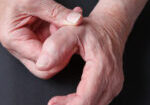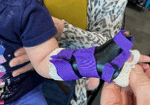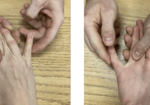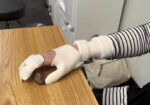Cyclist Injuries: Avoiding Hand Injuries and Treatment Strategies
Filed under Treatments
RAPID REVIEW
Chiaramonte, R., Pavone, P., Musumeci, G., Di Rosa, M., & Vecchio, M. (2022). Preventive strategies, exercises, and rehabilitation of hand neuropathy in cyclists: A systematic review. Journal of Hand Therapy, 35, 164-173.

The Skinny:
The study was a systematic review done to get clarification on the diagnostic process for cyclist injury specifically for hand neuropathies and strategies for prevention and treatment.
In the Weeds: Literature was searched in the following databases PubMed, EMBASE, the Cochran Library, and Web of Science.
Exclusion criteria excluded duplicate studies, injuries that were related to sports not specific to cycling, and articles that were not related to peripheral nerve injuries.
Inclusion criteria: Articles met the inclusion criteria if they included hand palsy due to peripheral nerve compressions of the ulnar and or median nerve specific to the cyclist injury.
Initially, the search yielded 15,371 articles, after screening for inclusion-exclusion a total of 48 full-text articles were read, and finally 20 publications that met the full criteria. Two separate reviewers independently reviewed identified articles.
Bringing it Home:

From the literature review, they concluded the following prevention and therapeutic strategies for treating common cyclist injuries.
1.) Educate cyclists on frequent changes in the position of the upper limb, neck, and shoulder
girdle (Anderson and Bovim, 1997)
2.) Adapt the handlebars or change position and change riding position (Haloua, et al,
1987)
3.) Minimize nerve compressions by avoiding prolonged elbow extension and
flexion, and wear neutral wrist orthosis and elbow orthosis at night. Use padded gloves (Dy
and Mackinnon, 2016)
4.) No treatment (Haloua et al, 1987, North et al, 1980 and Selcuk et al, 2015)
5.) Rest from the activity causing the compression (Malmaris and Zadeh, 1990)
6.) Cryotherapy, exercise, and electrical stimulation (Bransdma, 1995)
7.) Anti-inflammatory drugs and steroid injections (Ummer and Albohm, 1990).
There are a few treatments available for peripheral nerve injuries caused by cycling, however, there is no specific protocol for these injuries according to this systematic review.
Rating:
3/5
There is very limited evidence on treatment options for compression neuropathies caused by cycling. However, there have been a large number of studies looking at conservative treatment for peripheral neuropathies they are just not specific to one sport. The best course of treatment for cyclists is not clearly defined and this may require therapists to rely on their current clinical skills and other research.
References
Andersen, K. V., & Bovim, G. (1997). Impotence and nerve entrapment in long-distance amateur cyclists. Acta neurologica Scandinavica, 95(4), 233–240. https://doi.org/10.1111/j.1600-0404.1997.tb00104.x
Brandsma, J. W. (1995). Manual muscle strength testing and dynamometry for bilateral ulnar neuropraxia in a surgeon. Journal of Hand Therapy, 8(3), 191-194.
Dy, C. J., & Mackinnon, S. E. (2016). Ulnar neuropathy: evaluation and management. Current rev musculoskeletal med, 9, 178-184.
Haloua, J. P., Collin, J. P., & Coudeyre, L. (1987). Paralysis of the ulnar nerve in cyclists. Annales de Chirurgie de la Main: Organe Officiel des Societes de Chirurgie de la Main, 6(4), 282-287.
Kalainov, David & Hartigan, Brian. (2003). Bicycling-induced ulnar tunnel syndrome. American journal of orthopedics (Belle Mead, N.J.). 32. 210-1.
Maimaris, C., & Zadeh, H. G. (1990). Ulnar nerve compression in the cyclist’s hand: two case reports and review of the literature. British journal of sports medicine, 24(4), 245.
Noth, J., Dietz, V., & Mauritz, K. H. (1980). Cyclist’s palsy: Neurological and EMG study in 4 cases with distal ulnar lesions. Journal of the neurological sciences, 47(1), 111-116.
Ummer, C., & Albohm, M. (1997). Cyclist palsy in the 90s. Human kinetics. 20-21.
Selçuk, B., Kurtaran, A., Yildirim, Ö., Değirmenci, İ., & Akyüz, M. (2015). Cyclist’s Neuropathy: A Compression Syndrome of the Deep Motor Branch of the Ulnar Nerve: A Case Report. Neurosurgery Quarterly, 25(3), 337-340.
1 Comments
Leave a Comment
More To Read
Changes in ROM of the MCP after Trapeziometacarpal Arthrodesis
Rapid Review: Changes in ROM of the MCP after Trapeziometacarpal Arthrodesis Hayashi, M., Kato, H., Komatsu, M., Yamazaki, H., Uchiyama, S., & Takahashi, J. (2021). Changes in the Functional Range of Motion of the Thumb Metacarpophalangeal Joint After Trapeziometacarpal Arthrodesis for Patients With Advanced Trapeziometacarpal Osteoarthritis. The Journal of hand surgery, S0363-5023(21)00613-4. Advance online publication. https://doi.org/10.1016/j.jhsa.2021.09.018. The Skinny: Several published…
Read MoreSplinting and Stretch Protocol for Pediatric Trigger Thumb
Tan, A. C., Lam, K. S., & Lee, E. H. (2002). The Treatment Outcome of Trigger Thumb in Children. Journal of Pediatric Orthopaedics B, 11(3), 256-259. The Skinny:Pediatric trigger thumb is a “relatively uncommon” condition of unknown origins. Studies have indicated that spontaneous recovery of trigger thumb is around 25-40%, and chances increase with age.…
Read MoreHand Therapy Article Review: The Radial Synergy Test, An Aid to Diagnose de Quervain’s Tenosynovitis
Chihua, L., Langford, P.N., Sullivan, G.E., Langford, M.A., Hogan, C.J., & Ruland, R.T. (2021) The radial synergy test: an aid to diagnose de Quervain’s tenosynovitis. HAND. epub ahead of print;1-6. doi: 10.1177/15589447211057297 Rapid Review By: Case Peters The Skinny: de Quervain’s tenosynovitis is a common pathology that involves swelling and thickening of the tendon sheaths…
Read MoreWhat to Know as a Hand Therapist When Choosing Thermoplastic Orthosis Material
By: Kelsey Melton Thermoplastic materials can have a variety of properties. Each supplier has a different version of each combination of variables for the therapist to choose from. The most common brands used for orthosis fabrication are Orfit, NorthCoast Medical (NCM), and Raylan. These brands all have their versions of thermoplastic material that vary in…
Read MoreSign-up to Get Updates Straight to Your Inbox!
Sign up with us and we will send you regular blog posts on everything hand therapy, notices every time we upload new videos and tutorials, along with handout, protocols, and other useful information.







As a triathlete and a CHT this has burdened me for quite some time.
I struggle to find a balance between a comfortable grip on my handlebars and preventing hand numbness.